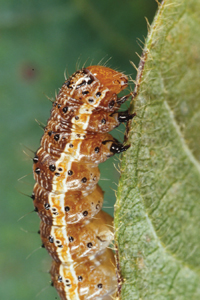
Features
Chemicals
Insects
Natural enzyme deters fall armyworms, other corn-feeding insects
March 13, 2008 By Fruit & Vegetable
Furnishing corn plants with genes
for producing the enzyme ß-N-acetyl hexosaminidase (NAHA) may offer a
way to fend off mold-spreading caterpillars and beetles, researchers
suggest. After hatching from eggs, fall armyworm caterpillars feed on
corn plant leaves before advancing on the ears, where succulent kernels
await.
 |
| Armyworm. Photo courtesy of USDA
|
Furnishing corn plants with genes for producing the enzyme ß-N-acetyl hexosaminidase (NAHA) may offer a way to fend off mold-spreading caterpillars and beetles, researchers suggest. After hatching from eggs, fall armyworm caterpillars feed on corn plant leaves before advancing on the ears, where succulent kernels await. Other caterpillars and beetle pests feed there, too. When husks are chewed open, kernels can become exposed to mycotoxin-producing fungi. Insecticide spraying within label recommendations helps prevent such feeding and contamination. But the practice can be costly to use and harmful to beneficial insects. As a possible alternative, scientists are testing modified strains of corn that produce NAHA throughout the crop plant’s tissues. In laboratory trials, 100 per cent of newly hatched fall armyworms that ingested NAHA-containing leaf tissue from some of the modified corn plants being studied died within three days. The degree to which the caterpillars stopped feeding on all of the modified corn plants depended on how much NAHA the plants actually produced, the scientists observed. Corn earworm caterpillars, another pest tested, were also adversely affected by NAHA-containing plants. NAHA is considered a promising defence for corn because it occurs in foods eaten by humans, such as cabbage and apple, and it targets chitin, a key component of insects but not of humans or other animals.
Print this page